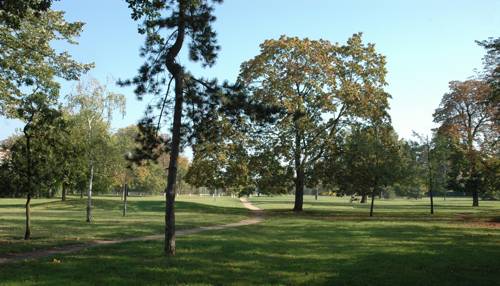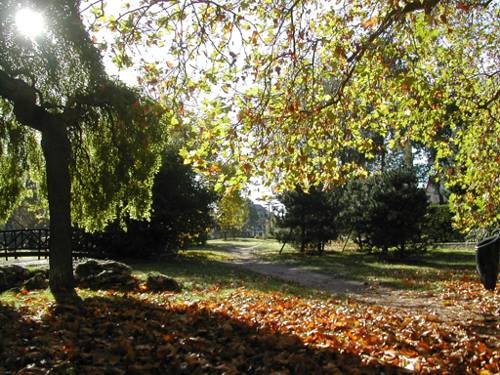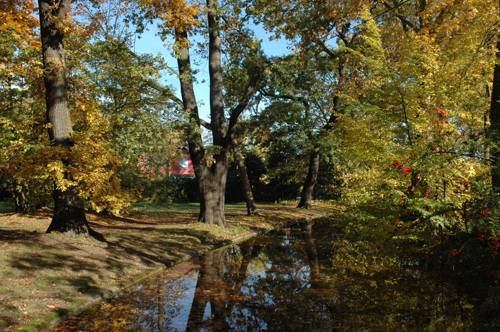![]() 1975 - Edited by Syndicat d’initiative et de Défense du Site du Vésinet
1975 - Edited by Syndicat d’initiative et de Défense du Site du Vésinet
Le Vésinet, Yvelines, France
West of PARIS - 7 miles from the ÉTOILE
a town in a garden, created by Alphonse Pallu and Paul de Choulot during the 2nd Empire
Close to the Château of Saint-Germain-en-Laye, the town of Le Vésinet occupies part of forest of Yveline which, long ago, covered all the area surrounding Paris.
On the verge of the cliff of St Germain-en-Laye, which overlooks a large landscape, Henri the IInd built a new castle. Later, Henri the lVth created «steped» gardens and decided to emphasize the perspective of the forest of Le Vésinet by tracing large alleys issued from a great circus. Louis the Xlllth stayed quite often in the new castle and Louis the XlVth was born there.
During the french revolution and the second Empire, the new castle was definitively deserted and the ancient castle given to the army; after these periods the parisians came back to St Germain-en-Laye and were interested by this marvellous set although part of it was ruined. So, when Pereire obtained the concession of the first french railway, he chose, in 1837, the passage from Paris to the forest of Le Vésinet.
One cannot doubt that the railway helped to the creation of Le Vésinet; this new and fast way of circulating can let one imagine that the forest of Le Vésinet could become an inhabited Park.
The ability of Alphonse Pallu, creator of Le Vésinet, is, that although he kept the historical outlook, he created, in a very short time, a quite orginal landscape. From 1856 to 1860 the park of Le Vésinet was drawn by the count de Choulot, and its roads and alleys, its rivulets and lakes were created; the first houses and Ste Marguerite’s church were built.Their plans can still be very clearly seen.
The wooded section is very thick, and transitions have been
created by remarkable landscaped links - swathes of lawn,
lakes, islands and rivers, and great avenues bordered with
trees. As you walk through the park formed by this town,
you never notice any breaks, imbalances, or lack of harmony.
The style of the floral displays is integrated in this very
special site: their appearance is natural, yet at the same
time sophisticated in the harmonies of the colours, the
volumes, and the design of the plants. The variety used
means that the beds can change throughout the summer, providing
new interest for the walker. The floral arrangements are
designed like impressionist paintings.
The inhabitants, who chose to live there after accepting the «cahier des charges» (a strict guide-line) immediately realized that they were building a new way of life. So, very soon, they decided to become a city, but the war in 1870, the decline of the second Empire, the political incertitudes, for all these motives Le Vésinet became a city only in 1875. This set of rules remains in place today. It states the guide-lines which tire land buyers had agree in order to preserve unique setting ofLe Vésinet.
These rules led to Le Vésinet to be classified in the Historic Sites inventory.
 |
..In the landscapes to be created nothing has to be small, the charm of the curves, the wide open spaces were to contribute to the sensation of largeness; everywhere, when it was possible, the stroller had to benefit of the beauty of the landscaping made of great masses of shade and light.[*] |
 |
The graceful and picturesque details of shade, light, flowers, grass and water lead to the most magnificent imagination [*] |
 |
"..As for the rivers, their size might seem small compared to the large open spaces, but imagination can do the rest. » «... they try to find as they possibly can, the shade of the trees and the freshness of the woods; rockeries and small waterchutes diversify the aspects and give motion to the picturesque parts."[*] |
For 150 years, the inhabitants of Le Vésinet, generation after generation, have kept the same way of life, the way of life Pallu and Choulot had imagined for them, and they have fought to keep their town just as beautifull as it was at first.
[ See also "The Cool Collection" ]
[*] The texts come from «L’Art des Jardins» by the count de Choulot.
Société d'Histoire du Vésinet, 2008-2014 – www.histoire-vesinet.org